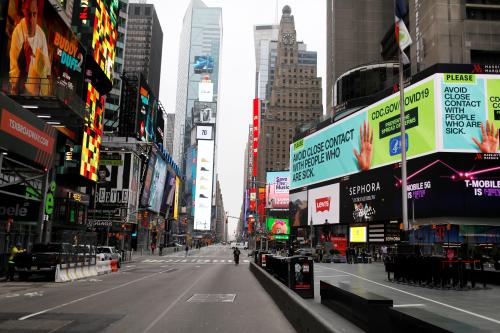The Brookings Papers on Economic Activity is the leading conference series and journal in economics for timely, cutting-edge research about real-world policy issues. Research findings are presented in a clear and accessible style to maximize their impact on economic understanding and policymaking. The editors are Brookings Nonresident Senior Fellow and Northwestern University Professor of Economics Janice Eberly and Brookings Nonresident Senior Fellow and Harvard University Professor of Economics James Stock. Read summaries of all five papers from the Spring 2020 journal here.
The video of the discussion can be found here.
This conversation took place during the Spring 2020 conference on the Brookings Papers on Economic Activity. Participants included Daniel Lewis of the Federal Reserve Bank of New York, Jan Hatzius from Goldman Sachs, and Lucrezia Reichlin of the London Business School discussing the economic outlook in the face of COVID-19. Robert Barro of Harvard University and François Velde of the Federal Reserve Bank of Chicago discussed lessons learned from the Spanish Flu, and Jason Furman and Jeremy Stein, both from Harvard University, discussed potential policy responses. Brookings Nonresident Senior Fellow and Harvard University Professor of Economics James Stock moderated the conversation.
STOCK: Obviously this is a time of great economic turmoil and there is enough to discuss that we could spend the entire afternoon on it, but instead of doing so, we’re going to spend the next 40 minutes on it.
So the first section with Daniel Lewis, Jan Hatzius, and Lucrezia Reichlin, is about the economic outlook, first in the United States, then in Europe. Daniel, you’ve got a couple of minutes.
LEWIS: So in the face of COVID-19, we need signals of real activity at a higher frequency than our familiar monthly and quarterly aggregates. By the time we see the March data it’s hard to know what the state of the economy will be. So to answer this demand, we [constructed] a weekly index of real economic activity using higher-frequency data. So, broadly speaking, you can see a few things in the high-frequency data, and Jan will go into much more detail on specific sectors later.
Consumer confidence has plummeted in the past two weeks. On the other hand, retail sales are through the roof, largely related to panic buying that was well documented. Elsewhere there have been only modest changes, falls in fuel production, falls in fuel sales, and the rise that we saw in UI [unemployment insurance] claims this morning.
It is important to emphasize that this data is only through March 14.
The index that we’ve extracted also tracks industrial production growth very well historically. There’s a similar relationship with changes in employment, paths to utilization, and [gross domestic product] GDP growth. So it really is signaling something about these lower-frequency aggregates.
Finally, I’d like to zoom in on estimates of real activity for the past few weeks, and especially last week, which ended March 14 for our purposes. Today’s UI numbers and the consumer confidence index have outweighed the movement that we saw coming from retail sales to show this negative effect and decline in real economic activity.
But recall that the shutdown is really happening this week, as we’ve seen documented in the media. On Monday alone in Massachusetts there were more new UI claims than there were in all of February. And so far this week, from only 15 states reporting, there have been 630,000 UI claims, whereas last week from the supposed surge we saw in UI claims, only 281,000 nationwide. So we think that our index is going to really start to show the possible full extent of the slowdown once we get data for this week ending March 21.
STOCK: Okay, thanks. Jan?
HATZIUS: Thanks, Jim. So both the U.S. and global GDP forecasts are plummeting much more quickly than at any point in my 23‑year career as an economic forecaster. Our current Q2 [second quarter] U.S. forecast is minus 5 percent.[1] But even though we only adopted that four days ago, five days ago, it’s already looking somewhat out of date, given the much more comprehensive lockdowns that we’ve started to see in different parts of the U.S.
So rather than discuss the exact numbers, I want to talk briefly just about how we should think of the hit to output and why it’s grown so tremendously over the past few weeks. When this looked like a Chinese crisis it was pretty difficult to get numbers much bigger than maybe a 1 percent hit to output in GDP outside of China. Obviously, China was down very sharply and much, much more than that. But, looking at the spillovers, it was pretty hard to get big numbers. Chinese tourists make up about 0.4 percent of non-China global GDP, so that was obviously going to drop sharply. But it’s ultimately a pretty small number. China goods imports are about 3 percent of non-China GDP. So if you assume a 20 percent drop, that’s worth 0.6 percent, and obviously with much less than that in some parts of the world, including the U.S. And then three supply-chain issues — because firms were unable to get components in China — were an issue in principle, but as recently as about four weeks ago or five weeks ago our equity analysts told us that U.S. industrial firms could probably last into Q2 without really significant issues by just burning through their inventory.
So I think it’s fair to say that it’s really only been the last two or three weeks that [most forecasters’ GDP numbers have] started to plummet. And the turn really came when it became clear that at least significant parts of, first, the Italian economy, then the euro-area economy more broadly, and then the U.S. economy were going to be locked down to reduce infections and combat the virus. And we’re still in the process of analyzing all the different transmission channels, and especially the different multiplier and amplification effects that we could be gathering via layoffs, bankruptcies, and damage to the financial sector. That’s all obviously very fluid.
But I think one basic part is just to look at which components of GDP are vulnerable to a sharp reduction in face-to-face interactions. We think that those categories account for about 15-20 percent of GDP. We very roughly estimate how much each of these categories might fall in a social-distancing or lockdown scenario. And we then multiply those assumed percentage reductions by the GDP share to get an impact on the level of GDP basically in the full-lockdown scenario or in the full-social-distancing scenario. And it’s probably not quite a worst case, but we get a hit to the level of GDP of something like 6 percent or 7 percent.
And you can then combine that assumption with a scenario for how long the outages last to get an estimate for the growth hit, at least from this channel. So if you assume you’re 6 percent below where you would be for one month, during April, that’s a 2 percent hit to the level of GDP on average during the quarter, and that’s a hit to the annualized growth rate of about 8 percentage points. If you assume the outage lasts for two months, then that roughly doubles, and so forth.
So it’s pretty easy to see how you can get some very, very large numbers, at least in the short-term. And,it also follows, of course, that if we do get a significant improvement in the virus situation and then a gradual loosening of the lockdowns and the return towards normal in at least significant parts of these activities, then we could see very rapid growth when that happens, provided we minimize these multiplier and amplification effects, layoffs, bankruptcies, and financial-sector damage.
STOCK: Thanks very much, Jan. Lucrezia, can you give us an update on Europe please?
REICHLIN: What I’m going to present [is] kind of forecasting with no data and so this is a nowcast for the euro-area economy — nowcast and forecast, so current quarter and one quarter ahead.
The problem, as everybody is aware of, is that we do not have data about the present.
So what we have done is tried to look at whether we could modify our model and put the euro area in the global context. So we have a model which is global in nature, and use the fact that China and other Asian countries are ahead of the game. So we already have a PMI [purchasing managers index] in different survey data for China, for Japan, and for South Korea, but in particular for China. China is the only country where the surveys already give us a signal for the current month of March.
This is our China nowcast. You see the [percentage] drop for China year-on-year. So for the first quarter of 2020 we have zero and for the second quarter we have minus two.
Now, when we see the implication of that for the euro area — not much for the first quarter of [2020], but a dramatic shift in the second quarter, which is probably too optimistic, okay, because this [is only] readily available data. And you see that for the euro area as a whole, we have something which is minus 0.3 percent change, quarter-to-quarter] for the euro area as a whole.
So this is our euro area nowcast. So then for Italy it’s something more dramatic, of course, because Italy as you know was hit first [in Europe] and also started from worse conditions. So for the second quarter we have Q-on-Q of minus 0.6 percent.[2] We believe that these numbers are too optimistic. So if we [apply] some judgment now, based on surveys on a range of minus 10 percent and minus 20 percent — the surveys that have not been published yet — then we get to numbers which are much more pessimistic — minus 0.71 for Q1, minus 1.51 for Q2.
STOCK: We have a couple of speakers now who have done some work looking into what we might learn from the Spanish Flu 100 years ago. One of them, Robert Barro, has a paper. So, Robert, why don’t you start off and then we’ll turn to François.
BARRO: I want to say some things quickly from joint work that’s ongoing with Jose Ursua and Joanna Wang.[3] We’re trying to use evidence from the great influenza epidemic of 1918 to 1920 to get upper‑bound estimates of the likely mortality and macroeconomic effects from the ongoing coronavirus pandemic.
So we’ve assembled annual death rates from the flu for 1918 to 1920 for 43 countries, which together represent about 89 percent of the world population at the time. The numbers show an overall accumulated death rate of 2.0 percent for the world as a whole, which corresponds to 39 million deaths. The experience was highly variable across countries. In our sample, the worst case is India, which was a 5.2 percent death rate, which corresponded to 17 million mortalities. And India was followed by South Africa and Indonesia in terms of the severity of the experience. The United States has a 0.5 percent mortality rate corresponding to 550,000 dead.
A particularly interesting case in the current context is Australia, which had a death rate of 0.3 percent, which is much lower than average among a sample of countries. Australia had an extreme maritime quarantine and other measures in 1918, which avoided the flu in that year, and the flu arrived only the next year. It was not merely a matter of deferring the flu deaths. The overall death rate was comparatively low. And it’s not about Australia being in the southern hemisphere, because in comparison New Zealand had a death rate that was more than twice as high and South Africa had one that was more than 10 times as high.
If you applied the world flu death rates from the great influenza epidemic, you get 150 million deaths worldwide, that’s at a 2.0 percent death rate. For the United States, you get 1.7 million at the U.S. much lower death rate of 0.5 percent. So obviously these are very staggering numbers.
A frequently mentioned number for the 1918 to 1920 experience is an infection rate of one third. That would imply that the fatality rate out of those infected, would have been 6 percent. In fact, the only data on morbidity that I know of that come from the great influenza period is for the United States. A study by Frost in 1920. It’s a well-done survey for basically 10 U.S. localities and it showed an overall infection rate of 29 percent. That number has basically been blown up to repeat this one-third estimate for the world as a whole. I think the right answer is the infection rate is unknown from the great influenza epidemic.
If we combine the flu death data with World War I death-rate data, there’s an important overlap in 1918 between the war and the great influenza epidemic. And if we also use long-term data that Jose Ursua constructed some time back on GDP and consumption, we get estimated macroeconomic effects from the flu of roughly a 6 percent reduction in GDP for the typical country and an 8 percent reduction in consumption. This is cumulative over 1918 to 1920. Those numbers are roughly comparable to the Great Recession period of 2008 to 2009.
We’re unable to say whether that decline associated with the great influenza was temporary or permanent. In contrast, negative effects were larger [in World War I], 8 percent [for GDP] and 9 percent [for consumption]. And in that case we’re able to estimate that about half of the decline was permanent and about half was temporary.
We also have some results in the 1918 to 1920 period — we’re really going back to 1914 — about asset returns and inflation. We found that the influenza epidemic, and especially the war, were bad for returns on stocks and also bad for real returns on assets analogous to short-term U.S. Treasury bills. And we also found a big burst of inflation at the time.
If you’re thinking about these results as being upper-bound estimates from the great influenza epidemic for the current setting, there are a number of things that are importantly different today. One is better public healthcare. Another is a greater extent of international and other interactions, at least until recently, which would go the other way in terms of predicting the effect. And the final thing, a much greater amount of mitigation. We have this remarkable basically self-constructed supply shock, which has already been commented on in terms of what the reduction in GDP is likely to be.
So what is unprecedented here is this seems to be a voluntary action aimed at trying to curb the spread of the pandemic.
STOCK: Thanks very much. François Velde.
VELDE: All right. The usual disclaimer applies. I am only speaking for myself. And I’m going to be focusing on the U.S.
Recalling the basic facts, the first wave of the epidemic started in spring 1918, was quite virulent but not very deadly. It started in the U.S., went over to Europe, and then it bounced back in the autumn of 1918. Now, that second wave was the one that we all talk about that was really deadly.
It’s kind of hard to trace the economic impact, even in the richest countries because this is the early days of data collection. This is before NIPA.[4] BLS [the Labor Department’s Bureau of Labor Statistics] and the Fed [Federal Reserve] are just starting up data collection, and the timing is going to make reliance on annual data a little tricky.
This picture [shows figure] is data on mortality from 47 U.S. cities, time on one axis and distance from Boston, where it all started, on the other axis. And if you look at that picture, it kind of gives you the main points of the epidemic. It went pretty fast. It started in September and it was basically over by December. Large variation in mortality rates by cities — in fact, huge variations. And you can also see that there is a second wave in a number of cities, but not all of them. And you can also see that it started pretty slow, but then it really sped up in November.
So the economic impact, it’s going to go through the labor force, in part because there was the unusual W shape of mortality. So a lot of people in the 25-to-35 age group were hit. And it was also virulent. Even if you survived, you were knocked out for several weeks. And then the so called non-pharmaceutical interventions, NPIs, which were decided at the city, or sometimes at the state level, what we call today social distancing. Almost all cities at some point closed school, churches, entertainment, large gatherings. The notable exception was New York City, which did not enact such a ban. And then there were other efforts to reduce congestion in cities and in public transport by having staggered business hours for businesses in some of the cities.
This picture shows you the duration of closings. The earliest is September 25 in Massachusetts and the latest is California that goes down to December 2. You can see the spread of the epidemic throughout this period. The median duration was about 28 days. So typically retail was shut down in those cities for about a month — the month being October roughly — or October-November.
So that’s the extent. Was it effective? There’s this piece that’s been going around, highlighting the case of Philadelphia and St. Louis. As you can see on the picture, Philadelphia is the top, St. Louis is at the bottom. They’re the most extreme cases. So it may be overstating it a little bit. But it is the case that there is a positive relationship between the timing of closings and the peak mortality.
So looking for impact, I’m going to compare with the 1920 recession, which is interesting because it happened not long after, so it’s still the same kind of economy. But the 1920 recession was widely blamed on the Fed tightening too early.
Here’s the graph of industrial production. In the first of the two yellow stripes, the NBR [National Bureau of Economic Research] peak is August 1918, and the trough is March 1919, so that’s pretty clearly coinciding with the epidemic. And, yes, you can see a hit to industrial production, but you can also do the comparison with the 1920 recession, which was much worse and much longer also.
Business failures, kind of a lagging indicator, as reported in Bradstreet, but you can still see them rising, both in number and in size during the 1920 recession. The 1918 flu pandemic recession, you couldn’t even notice it if I didn’t tell you that it was on this graph.
Bank clearings, which are kind of the volume of payments transactions: bank clearings do [show the effects of the 1920 recession], although somewhat late. In the 1918-1919 recession, there is a bit of an impact, but it’s really not very huge and it’s over fairly quickly and then the volume of payments rebounds quite fast.
The Fed did nothing. This is a graph of the interest rates. The different districts set their own interest rates at the time, so I have to plot all 12 districts. But you can basically see 1918, if anything, the Fed raised rates a little bit during that time.
And what about the stock market? [It] sailed through that one. This is the Dow Jones Industrial[Average], it went up 10 percent from August to the peak of the epidemic in November, and then it fell back after the armistice, moved sideways, and then after that went gangbusters. Again, the comparison to the 1920-21 recession is pretty instructive.
So maybe not quite the impact that you’d expect. It is visible, but it is not as large as the 1920-1921 recession, and there was a quick rebound, which is [noted] by the commentary that you see in the press at the time. Of course the context is very different in many dimensions. The federal government is running a massive 20 percent GDP deficit because this is the war and we have to beat the Huns. And the Fed is busy monetizing it. And the armistice comes as the closings end, so there’s an immediate focus on the transition to peace, what’s going to happen to government contracts, how are you going to make the transition to peacetime economy. It still is a useful case study, showing that a pandemic is not always a[n economic] disaster, and also bad monetary policy can really [make it] much worse.
STOCK: Thanks, François. That’s a very useful transition to the next two panelists. Jason Furman, can you give us a few words on the fiscal response? We’ve all been reading a lot about it, but we could learn more from you.
FURMAN: Congress and the President, between them, have already undertaken about $200 billion worth of measures — an $8.3 billion bill to directly respond, a roughly $150 billion bill that was signed by the President last night that includes paid leave, assistance for Medicaid, and a sprinkling of other stuff for unemployment insurance and nutritional assistance, and also the nearly $50 billion in disaster aid for states.
Right now the general set of conversations are around something that would be roughly another $1 trillion. The Senate Republicans have been negotiating with President Trump to figure out what those two parties think. They would then go to the Senate Democrats and then to the House Democrats. All of them at this point have different theories. [Half of] the President’s plan would be in the form of checks — $1,000 an adult, $500 a child — and half in the form of loans primarily to small businesses, but also industries like airlines. Senate Republicans might be in that place. The Democrats in both chambers right now are very resistant to broad-based checks, preferring to rely on more-targeted assistance like unemployment insurance and expansion of programs like the earned income tax credit, child tax credit, and the like.
That’s a brief rundown of the state of play as to where things are right now. I’ll say what I think in broad terms are the goals of fiscal stimulus and a little bit about what I think might or might not accomplish that.
There are, I think, four goals. One is the direct response — the money for ventilators, money for tests. And let’s just leave that aside, because that’s going to be done and that doesn’t have a macroeconomic goal.
Second is relief for families, making sure that people can buy food, keep the lights on, et cetera.
Number three is business continuity. Businesses are a network of social relations and firm‑specific capital on the part of their management, their workers, their suppliers, their customers, their banks, et cetera. Dissolving all of that makes it very difficult to reconstitute it and difficult to have growth coming out of this.
And the fourth is recovery for the economy after the virus. So leaving aside, as I said, the direct response for relief, the big quandary has been that the United States doesn’t have a great social insurance infrastructure. Paid leave is nonexistent. Unemployment insurance is run by separate systems in every one of the states, systems that in my experience in the last financial crisis had a real difficult time even reprogramming their computers to add extra weeks for people’s unemployment insurance. And that was a much simpler thing to do at a time when government employees were able to actually work in the office.
And so there’s this desire for targeted relief, but this worry that we don’t have a social insurance infrastructure for it. One way to handle that is checks for everyone, something I’ve advocated, something President Trump has proposed. The idea there is that you’re going to err on the side of over‑targeting. You’re going to get people that don’t need the money, but you won’t miss anyone that does.
Other forms of relief rely essentially on the private sector to advance the money to people and then be reimbursed later. That is the structure of the paid leave that President Trump signed into law, I think last night. Businesses would provide sick leave and paid leave, they would advance the money to their employees, and then about three months from now they would be paid back in the form of tax credits. That has the advantage of being very fast; it has the disadvantage of being in some ways precisely the opposite of what we want to do right now. That is about businesses lending money to the government to pay for social insurance when we want the government lending money to businesses. But there is an exigency and a concern that there weren’t other channels.
That brings me to business continuity, the third goal of any stimulus. And you have the same issue there. There are lending proposals, proposals to lend money and have that money be forgiven. And there are grant proposals that take the form — for example, Saez and Zucman, of paying the payroll of companies. Hubbard and Strain reportedly — I don’t know if they’ve put it out — [suggest] loans to small businesses that can be forgiven, et cetera.
You could imagine business continuity costing $1 trillion or $2 trillion if you did it in the form of grants and you are compensating businesses for their losses and keeping them going. If the suppression period lasted six months, that number would go up astronomically.
In the loan-type provisions you have the same issues you have with individual relief. The government couldn’t stand up a direct loan program for 30 million small businesses; it has to be channeled through the banks. To channel it through the banks, Germany has done an 80 percent loan guarantee. Proposals floating around here are more like 100 percent loan guarantees, plus subsidies for interest.
So the business continuity [goal] is the one that I think is in some ways [where there is] the most need for economists to figure out what the right answers are and figure them out very quickly.
Then the final goal of all of this is post-virus recovery. I think in some ways the relief and the business continuity are meant to speed up the post-virus recovery. If people don’t spend their checks now, their balance sheets will be in better shape and they’ll be in a position to spend later. So I don’t think we’re too concerned about what the multiplier[5] is in the short run, we just want it to be there over time. I think the other part of the post-virus recovery is just recognizing the tremendous uncertainty we’re operating under, and so making sure any response is capable of responding to that uncertainty. You might think Congress could adjust on a discretionary basis going forward. I have less confidence in that happening, and so [I am] much more of an advocate of making sure we have triggers, either at the state level or the federal level.
So just to summarize: It will be a very large response [and] it will include relief to individuals. I should have stressed [that the] states, by the way, could lose $300 billion. I think business continuity is the real open question. How you do that? And I think the goal of a lot of this is not just to get through this period, but to make sure that the recession of [1923-1924] caused by a premature Fed tightening becomes more memorable to history than the pandemic of 2020.
STOCK: Okay, thanks very much. Jeremy, we all know that the interest rates are not at the zero lower bound, but what else?
STEIN: I’ll talk about the Fed for just a few minutes. As Jim said, not only have they cut rates to zero, they’ve burned through a lot of the existing toolkit at an amazingly fast clip. I won’t say too much about the stuff they’ve done already. Rates are at zero, that’s fine [but aren’t] expected to have much impact in the near-term. You can think of [a number of the other things they’ve done in the past week or so] as measures designed to deal with problems of market function and short-term liquidity strains. For example, the Treasury market is really quite dysfunctional right now. It’s a little unclear to what extent that has to do with mechanical things, of the market makers not being at their normal desks, versus funding problems.
The good news [is that] this is the kind of stuff that the Fed is most easily equipped to deal with. So they are really going at this pretty hard. They have done an average of $45 billion of bond purchases a day. Just to put it in context, that’s approximately what they were doing a month under in QE3.[6] So they’re really working on this. And, again, I think it’s less of a monetary policy move than it is a market-function move.
Other things in that vein: They’ve rolled back out the commercial paper funding facility to help banks and corporations deal with short-term liquidity shortages; they’ve opened back up the primary dealer credit facility, which is essentially a discount window for nonbank dealers; [and] they’re being quite aggressive in offering swaps to foreign central banks, again to deal with shortages of dollar funding. And I think all of that is directionally right and helpful.
Let me mention a couple of other things that have yet to be dealt with. And these are more in the spirit of not just short-run liquidity problems, but deeper issues of intermediary solvency and protecting the ability to extend credit on a sustained basis. And this gets very much to Jason’s point of will we have the financial system there when the economy is ready to come back and recover.
Here’s the first I think fairly significant policy mistake that I’ve seen, which is bank dividends. The Fed has made an initial move that, at the margin, makes it a little easier for banks to continue paying dividends as they start eating into their capital. I think that’s exactly the wrong thing to do. If we’ve learned anything from the last time around, it’s they should immediately get banks to curtail their dividend payments. Just to give you a sense of magnitude, last year banks paid about $180 billion in dividends. So that’s a pretty meaningful chunk, that’s a percentage point or two of capital. And they should be hanging onto that.
And just to be clear, I’m not claiming that I know or will predict the banking system is going to be having solvency problems. Obviously the tail [risk] on all of this is extremely left-skewed. But, even if you don’t think that, we know that a tremendous amount of credit in the economy now is being provided not by the banking sector, but by a bunch of other players outside of the banking sector. I think there was enormous boom in leveraged lending, collateralized loan obligations, all of that. You can have a fairly high level of certainty that some of that is going to be badly, badly damaged. And beyond having the banks just stay afloat, ideally you’d like them to have the capacity to pick up some of the slack. So I would be pushing very hard on the banks.
The communication is delicate. You don’t want put out anything that says that their solvency is jeopardized. You don’t want to cause a panic. But I think to the extent that you can message it as the banks are solid, but in doing their patriotic duty they’re going to try to maintain or even strengthen their capital base so that they can play a leading role in helping the recovery. I think that’s a useful message.
The only other thing I’ll mention that hasn’t been stood up yet, but that I think is probably going to have to come in some form or another, is some version of what was called the TALF[7] last time around. It was a joint Treasury-Fed venture where the Treasury put in a layer of equity capital to a special purpose vehicle, and then the Fed lent to that vehicle so it could acquire highly rated slices of asset-backed securities.
Now, one problem last time around is that they tried to this very thoughtfully and carefully, tried to get the haircuts on each of these securities sort of accurate, and it took three or four months to get it stood up. I think here you’re going to want to do something in this broad spirit, but a little. maybe a lot, sloppier and faster so it can get going.
Now, of course, that runs the risk — well, not the risk, but it runs the near certainty that the Fed will lose money if it makes some of these loans. And then I think we basically have an implementation question. As Jason said, [we’re] going to want a bunch of lending to the private sector to help them roll their debts. Whether that’s done with direct fiscal money or whether it’s fiscal money essentially levered by the Fed, that’s a tactical implementation thing. I think maybe that for smaller businesses it’s easier to connect them to the banks. For larger firms that are issuing securities, it’s easier to do it through the Fed. But I think probably you’re going to want to have both just because we don’t really know how well things are going work. So you certainly want to stand it up, whether it does a lot of business in the end, [it’s] harder to say.
But I hope that between the Fed and the Treasury, they can get it going relatively quickly and not worry about getting it quite as fine-tuned as it was last time around.
STOCK: We are out of time, but I am still, even though we are out of time, going to ask just one question. And that is you can imagine that unless this virus miraculously, as someone has said, disappears from the population over the course of the next few months, that it’s a reasonable scenario that we might be in this lockdown setting for quite a while, measured in quarters.
What do you see, Jason and Jeremy, in terms of effective policy responses in that event? It seems to be a much more dire situation.
FURMAN: Yeah. First of all, I think that there’s a non-trivial probability that the lockdown is six months. I think there has to be at least a 30 percent chance of that, and some chance it’s much longer than that. I have not worried at all about our fiscal capacity. Interest rates have gone up a little bit in the last few days, but they’re still quite low. We could pay the salaries of all the shutdown businesses for a month or two. I would start to worry about our fiscal capacity to pay the salaries of all the shutdown businesses for six months or nine months, start to worry about where the money was going and what it was paying for.
And finally, Congress is of the view now they can’t vote remotely. Nancy Pelosi is insistent they can’t. I don’t know how the Congress is going to meet. I assume they’ll change their mind and decide they can vote remotely.
So I think that was all a long non answer to you, but I just think more of everything we’re talking about now in some sense would be necessary. And I guess even if the United States hits fiscal constraints, we’ll still be in a better position to borrow than any other actor in our society, whether it’s a business or an individual
So I think it will just get exceedingly, exceedingly expensive.
STOCK: Jeremy?
STEIN: Obviously there will have to be an enormous, enormous fiscal tab for all of this. [What] you want to start thinking about now is can you to some extent privatize some –- obviously, you can’t privatize most — but can you privatize some of the losses? [It is] the difference between continuing to pay American Airlines’ debt for them versus pushing them through Chapter 11, or, making the banks essentially restructure a bunch of their small-business loans and write off 20 percent of them versus having the government continue to keep those loans current. So you want to start thinking about where are the pockets of loss-absorbing private capital, be it airline shareholders or bank shareholders.
And so part of my desire to keep the banks well capitalized is in part the desire — in case this plays out longer — to have more private capital standing there. Again, I don’t think you’re going to get the government dramatically off the hook. I think it’s also a social-fabric issue. If this goes six months, this country is going to be falling apart. And if it looks like we’ve let bankers continue to pay dividends to their shareholders and pay bonuses and not take their fair share of the pain, I think there will be more fallout on that dimension as well. That [is why I propose] trying to share the losses to some extent.
STOCK: Okay. So thanks and keep up the good work for everybody who’s involved in this. We need your help.
References
[1]Goldman Sachs updated its forecast on the morning of March 20, 2020. It forecast quarter-on-quarter annualized growth rates of minus 6 percent in Q1, minus 24 percent in Q2, plus 12 percent in Q3, and plus 10 percent in Q4, leaving full-year growth at minus 3.8 percent on an annual average basis and minus 3.1 percent on a Q4/Q4 basis.
[2] In Europe, unlike the U.S., the convention is to describe quarter-to-quarter changes in GDP without expreessing them as an annual rate. So Reichlin’s 0.6 percent would be expressed in the U.S. as about a 2.4 percent annual rate.
[3] https://www.aei.org/research-products/working-paper/the-coronavirus-and-the-great-influenza-epidemic-lessons-from-the-spanish-flu-for-the-coronavirus-potential-effects-on-mortality-and-economic-activity/
[4] The national income and product accounts produced by the Commerce Department’s Bureau of Economic Analysis.
[5] The effect of the government spending program on gross domestic product.
[6] The Federal Reserve’s third round of quantitative easing (securities purchases) during and after the Great Recession, September 2012 to October 2014.
[7] The Term Asset-Backed Securities Lending Facility helped market participants meet the credit needs of households and small businesses by supporting the issuance of asset-backed securities collateralized by loans of various types to consumers and businesses of all sizes.













Commentary
The economy and policy in the coronavirus crisis to date
March 20, 2020